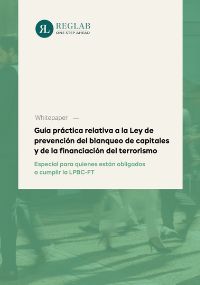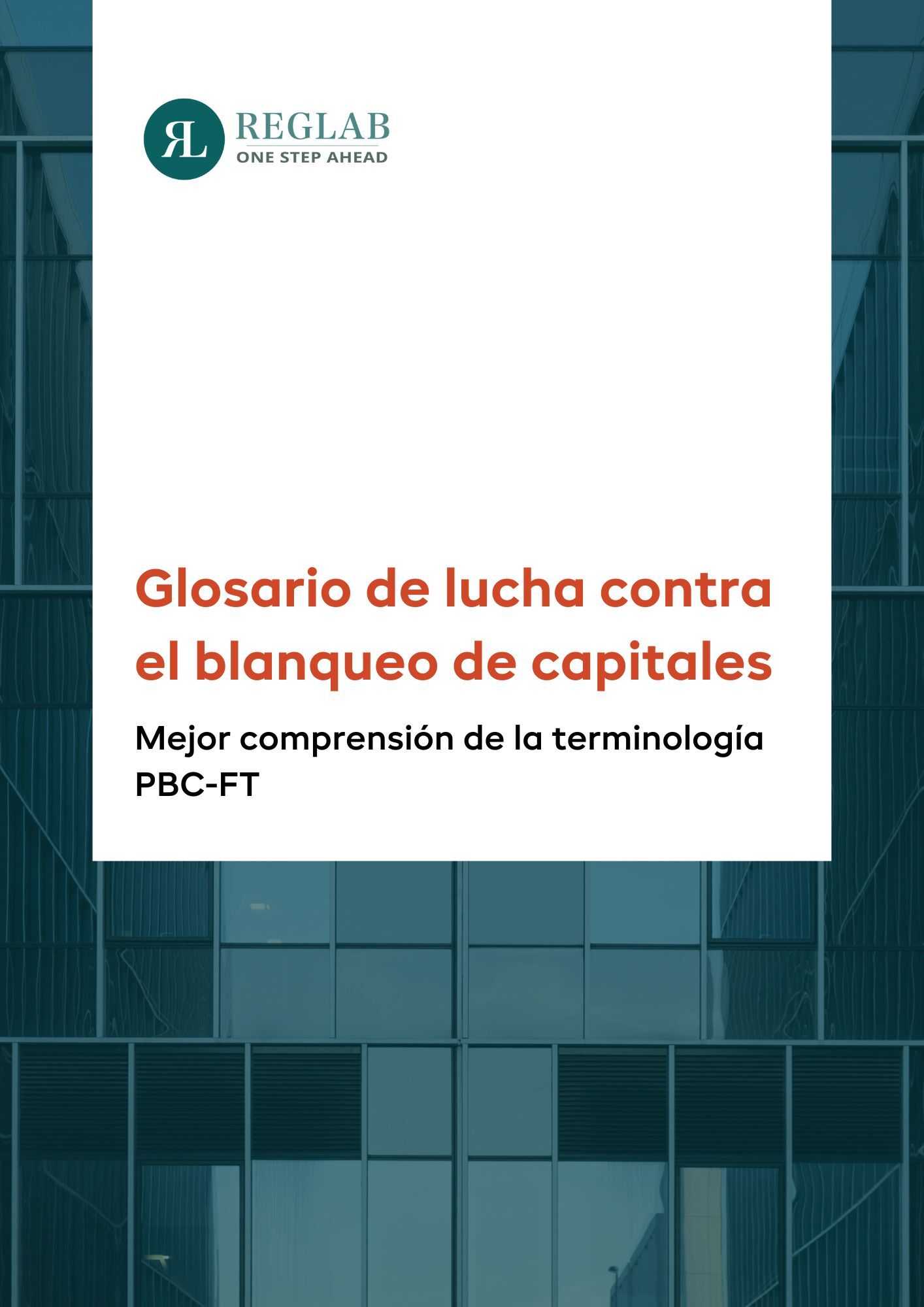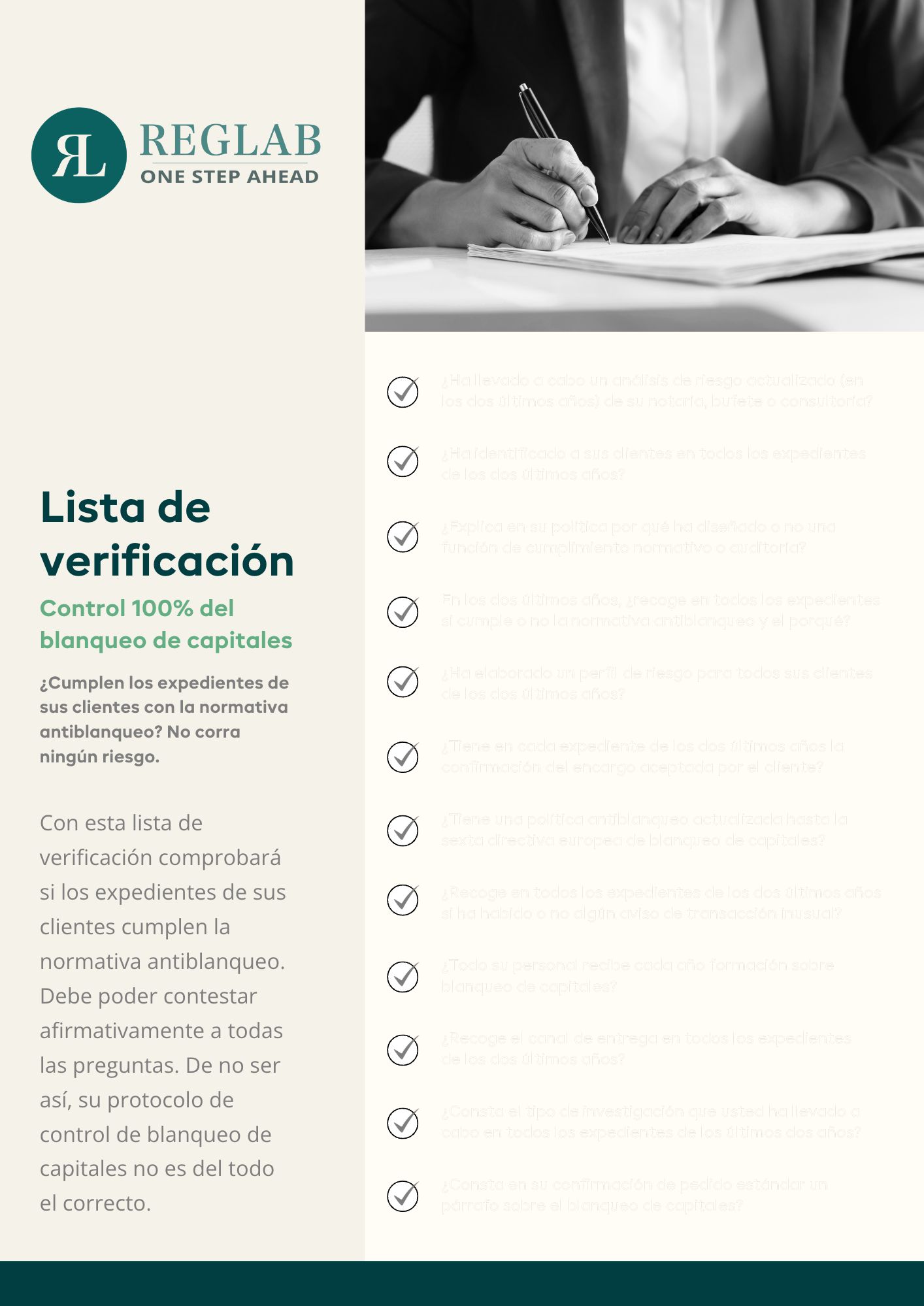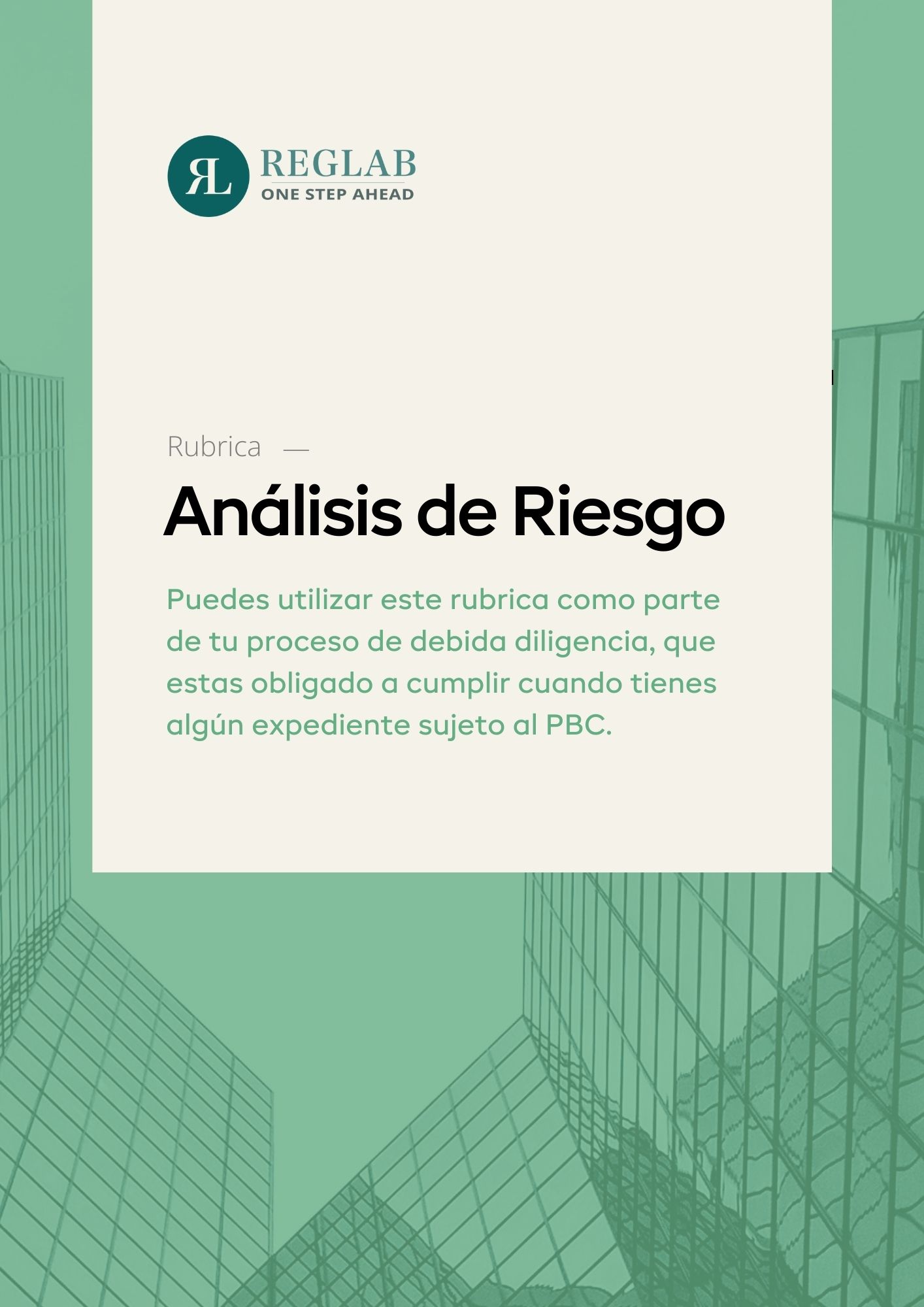- Productos
- RegLab para...
- Centro de conocimiento
Descargue nuestro whitepaper sobre mitos PBC >
 Hemos recopilado diez mitos sobre la prevención del blanqueo de capitales y ofrecemos consejos prácticos para mejorar tu proceso.
Hemos recopilado diez mitos sobre la prevención del blanqueo de capitales y ofrecemos consejos prácticos para mejorar tu proceso. - La empresa
Sobre nosotros >
Trabajamos con la convicción de que una incorporación transparente y eficaz es el principio de una relación óptima con el cliente.
- Solicitar una Demo
Centro de conocimiento
Conoce el centro de conocimiento de RegLab. En punto de inicio para encontrar white papers, testimonios de clientes, y blogs. Aquí encontraras mas informacion sobre los seis temas mas importantes de las leyes de PBC.
100% a prueba de LPBC-FT
A continuación presentamos un número de artículos dirigidos a profesionales legales para preparar su oficina antes de la visita de auditorías, complementado con útiles fuentes de información que puedes aplicar directamente en la práctica. Este contenido está basado en las Preguntas Frecuentes de los supervisores durante las auditorías.
Como abogado y profesional legal, se requiere que sepa identificar y certificar a sus clientes desde el principio. Adicionalmente, debe cumplir tambien con las leyes de PBC. Es responsabilidad suya cuestionar críticamente y tener reportes detallados sobre el cumplimiento de las normativas de PBC con respecto a cada cliente. Debe tener estos documentos listos en caso de una visita de las autoridades reguladoras. ¿Sabe si cumple todos los requisitos, sin tener que molestar a sus clientes y colegas?
¿Cómo se determina si un asunto está sujeto a AML?
El supervisor está a punto de visitar su oficina. Su primera pregunta será la siguiente: "¿Cómo se determina si un asunto, o un expediente, está sujeto a AML? En este artículo, le ayudaremos a formular correctamente su respuesta a esta pregunta.
¿Puede mostrarme sus registros AML?
El supervisor está a punto de visitar su oficina. En este artículo, abordamos la siguiente pregunta del supervisor durante una auditoría en su despacho. La pregunta es esta: "¿Puedes mostrarme sus registros AML?"
¿Cuenta su despacho con una política de riesgo por escrito?
Puedes esperar esta, y preguntas similares con respecto a su política de riesgo durante una auditoria, de acuerdo con las secciones 2a (1) y 2b (1) de la Directiva de PBC. Sin embargo, no siempre es fácil responder satisfactoriamente.
¿Hay una política de PBC estandarizado?
En este artículo, iremos más a fondo sobre la implementación de estas políticas y su importancia para el supervisor. Pregunta 4 del Supervisor: ¿Tienen una política de PBC estandarizada?
¿Se están tomando cursos de AML en la oficina?
Puede indicat si usted y / u otros empleados de la oficina están tomando cursos de AML? Cuál es la frecuencia de los cursos? (Artículo 3 AML Supervision Policy Rule 2018) y cuándo se llevó a cabo el último curso?
¿Cómo ha diseñado el puesto de oficial de cumplimiento?
El puesto de oficial de cumplimiento se ha introducido en la profesión legal en los últimos años. Esto se debe principalmente a que el AML requiere que las grandes empresas designen un oficial de cumplimiento.
¿Alguna vez ha declarado transacciones inusuales?
¿Cómo reacciona si el supervisor le hace esta pregunta (artículo 23, apartado 1, de la AML)? Para cumplir con los requisitos AML tiene dos obligaciones principales: debe identificar a sus clientes y debe informar cualquier transacción inusual.
¿Tiene su Hoja de Encargo profesional un párrafo sobre PBC?
Un elemento importante de la auditoría implica la revisión de su hoja de encargo profesional. ¿Cómo se ve una hoja de encargo profesional? ¿Tiene una hoja de encargo profesional para cada archivo y dónde la guarda? ¿Se ha incluido un párrafo sobre la PBC?
LPBC-FT: Los seis temas mas discutidos
Debajo encontrarás un resumen de los temas mas discutidos a lo largo de este último periodo.
AMLR y AMLA
El AMLR es el nuevo reglamento europeo contra el blanqueo de capitales que entrará en vigor en 2027. ¿Qué cambiará para su empresa? Lea todo sobre el AMLR y el nuevo regulador AMLA en este artículo.
Explicando la directiva sobre el AML
El AML o Prevención de Blanqueo de Capitales y Financiamiento de Terroristas por sus siglas en inglés, es el termino para la legislación internacional en la que se basa la Ley de PBC-FT española. A nivel europeo, esta regulación se conoce como la quinta directiva de AML.
PBC: las cinco preguntas más frecuentes
En este artículo, leerá sobre las cinco preguntas más frecuentes en torno al PBC. Por ejemplo ¿Por qué se creó la LPBC-FT? y ¿Cómo interfiere el AML con la debida diligencia del cliente?
KYC: el significado
Cada institución financiera europea debe evaluar a su cliente antes de aceptarlo. En primer lugar, las acciones que debe realizar para garantizar un procedimiento KYC sólido son las verificaciones de antecedentes. Este artículo ayuda a explicar de qué se trata KYC y por qué es importante la diligencia debida del cliente (CDD).
Ley de PBC-FT: su importancia
La Ley de PBC-FT data de 2010 y fue creada para combatir el lavado de dinero y terrorismo. Conforme a esta ley, España implementa las sanciones que se encuentran vigentes en el plano internacional, en las Naciones Unidas y la Unión Europea. La Ley de PBC-FT es compleja. Explicamos un poco más de esto en esta página.
¿Qué es y cómo identifico una PEP?
PEP significa Persona Políticamente Expuesta. Debido a su posición influyente, se asume un mayor riesgo de blanqueo de capitales, por ejemplo. Pueden ser acusados de actos como sobornos, evasión de impuestos y financiamiento del terrorismo.
Beneficiario final: ¿Qué es eso?
Un Beneficiario Final es una persona o personas que ejercen el control efectivo final sobre una persona jurídica u otra estructura jurídica. Si tu expediente está sujeto al PBC-FT, entonces es necesario investigar al Beneficiario Final, de lo contrario sanciones podrían ser impuestas.
¿Qué son los (Pseudo)UBO?
Cualquiera que esté relacionado con el cumplimiento de la normativa contra el blanqueo de capitales, los servicios jurídicos o las estructuras corporativas financieras habrá oído hablar de la palabra UBO. Pero, ¿conoce también la palabra pseudo-UBO?
LPBC-FT: Biggest challenges
A continuación se ofrece un resumen de las cuestiones que destacan para nuestro responsable de cumplimiento. ¿Cuáles son los mayores retos y dónde hay margen de mejora? Puede leerlo en los artículos siguientes.
¿Cómo configuro el proceso PBC/FT?
Descubra los pasos esenciales para establecer un proceso exitoso de PBC/FT y aprenda a evitar trampas. Descubra los pasos esenciales para establecer un proceso exitoso de PBC/FT y aprenda a evitar trampas.
Actualización de política AML
La política de PBC-FT consiste en una parte dinámica de su firma. He notado que las firmas encuentran dificultades para afrontar con esto de forma activa. En este blog, destaco los tres errores más frecuentes y escribo algunos consejos prácticos.
Información requerida
Debe siempre identifica a su cliente (potencial). Para identificar personas naturales y entidades legales, se solicitan varios documentos. Este artículo explica cuáles son estos documentos de acuerdo con la legislación de PBC-FT.
Investigación PBC-FT
No solo se investiga a los clientes para revisar si aparecen o no en la lista de sanciones. También se revisa las listas de países de alto riesgo para cada persona involucrada en el asunto. En este artículo se hablará de qué investigar y qué hacer si un cliente se encuentra en una lista.
Evaluación de riesgos
En este artículo se analiza la importancia de las políticas de riesgo y los perfiles de riesgo. Averigüe exactamente qué significan ambos y cómo aplicarlos.
Perfil de riesgo de PBC
En este artículo, respondemos a las preguntas más frecuentes sobre el perfil de riesgo de AML. ¿Cómo decido el perfil de riesgo, qué escribo y qué tipo de investigación (y seguimiento) hago?
¿Investigación reforzada o periódica de los clientes?
Para nosotros, la clasificación de riesgos es la parte más complicada. ¿Cuándo realizar una investigación de clientes avanzada o estándar? En este artículo se lo explicamos.
Origen de los fondos y de la riqueza
Debido a la lucha contra el blanqueo de capitales, es posible que se exija a las entidades obligadas que obtengan información sobre el origen de los fondos o el patrimonio de un cliente. Pero, ¿qué implica esto exactamente?
Monitoreo obligatorio de clientes
Una de las obligaciones más importantes de AML es la siguiente: monitorear clientes regulares. ¿Cómo hacerlo cómodamente y puede ayudar el software PBC?



Información valiosa
Los siguientes artículos ofrecen información valiosa sobre el PBC y otras normativas a las que se enfrentará durante la incorporación de clientes (potenciales).
Firmas colaboradoras
Las firmas regularmente se refieren entre ellos mismos a sus clientes. Desafortunadamente, las cosas a veces salen mal dentro de esta estructura colaborativa en lo que respecta a las obligaciones de PBC-FT.
Informes
Lo que muchos usuarios de RegLab no saben es que se pueden crear rápidamente análisis completos de AML. En este artículo te explicamos cómo funciona y te contamos cuáles son los análisis más útiles para las empresas.


Una guía (muy) práctica para PBC
— Whitepaper
Especialmente diseñados para aquellos que necesitan cumplir todos los requisitos de las leyes PBC.
Mitos sobre PBC
— Whitepaper
Hemos recopilado diez mitos sobre la prevención del blanqueo de capitales y ofrecemos consejos prácticos para mejorar tu proceso.
Glosario de PBC-FT
— Glosario
Descubra la terminología clave para el cumplimiento eficaz de la normativa en materia de PBC/FT.
100% a prueba de LPBC-FT
— Ficha informativa
¿Está seguro de que cumple con todos los requisitos de PCB? No se arriesgue.
Análisis de Riesgos: Rubricas
— Análisis de Riesgos
Evalúe fácilmente el nivel de riesgo de sus clientes.
Testimonio —
Hamelink &
Van den Tooren
“No tuvimos ni una queja por parte del regulador durante las inspecciones de las auditorías”
— Leer más
Testimonio —
Svalner Atlas Advisors (antes Atlas Tax Lawyers)
“RegLab nos ha ayudado a automatizar nuestros procedimientos”
— Leer más





































